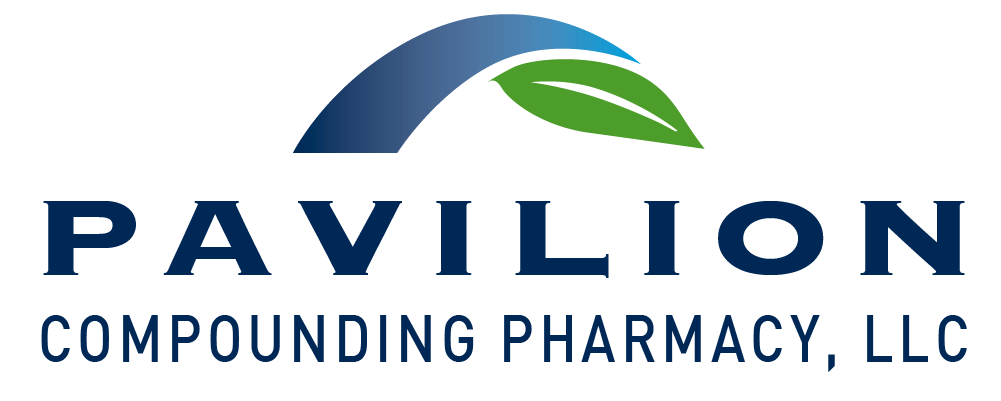As women enter the menopausal age, hormones start declining, and without therapy, symptoms of menopause become worse. With this hormone loss, the vaginal epithelium becomes atrophic and physiological lubrication is reduced. This can lead to physical discomforts, such as vaginal dryness, irritation, itching, burning, dyspareunia, all of which can lead to decreased libido, causing sexual distress both to the patient and her partner. Pavilion Compounding Pharmacy offers many treatment options, including non-hormonal options to treat vulvovaginal atrophy.
Treatment for Vulvovaginal Atrophy
Conventional treatments for vulvovaginal atrophy include intravaginal conjugated estrogen or estradiol; however, other studies have provided compounders with alternative choices. Vaginal moisturizers can improve the balance of intracellular fluids in the vaginal epithelium. Vaginal lubricants have more of a short-term action because they act as a mechanical barrier between the vaginal epithelium and the external environment, improving the dryness related to sexual activity.
Hyaluronic Acid, Vitamin E, Vitamin
In 2008, Constantino and Guaraldi published a study that used a vaginal suppository containing hyaluronic acid sodium salt 5 mg, vitamin E acetate 1 mg, and vitamin A palmitate 1 mg. Dosing was a suppository intravaginally every night for 14 nights, then tapering to every other night for 14 nights. Of 150 women, 126 completed the study in full. The study assessed the efficacy of the study medication in the areas of burning, itching, dyspareunia, inflammation, and irritation. Results showed that any symptom that was reported as severe initially was resolved to either mild or absent at the end of four weeks.1
Hyaluronic acid helps to form an extracellular water film, which moisturizes the skin, maintaining a water balance and aiding in skin elasticity. It also facilitates the healing process and tissue regeneration. Vitamin E, which has antioxidant properties, also acts as an anti-inflammatory and healing agent. Vitamin A has been shown to increase the function of the immune local cells and the epithelium of the vagina. Compounding hyaluronic acid in combination with vitamins A and E in an intravaginal cream (suppositories are difficult to compound with hyaluronic acid) provides an alternative for patients who cannot use hormones. Vitamin E intravaginal cream or suppository can be used in addition.
Estriol and Progesterone
Chollet et al. (2009) evaluated the safety and efficacy of a vaginal suppository compound for vulvovaginal atrophy. They gave participants estriol 1 mg and progesterone 30 mg daily for two weeks, then three times weekly for a total of six months. In a study group of 19 women, results showed improvement in vaginal pH, vaginal dryness and libido. The researchers performed follow-up endometrial biopsies and noted no hyperplasia or carcinoma at six months of treatment. They also measured serum estriol concentrations at baseline, pre-insertion of the dose, five hours post-dose, at week two, and at months three and six. What is interesting to note is that the estriol serum level did not differ statistically from baseline to pre-insertion dose, at week two, or at months three or six, suggesting that estriol has minimal systemic accumulation, as reflected in the study.2
Serum progesterone levels increased at all time points, with a median serum level that was less at month six when compared at month three. Also, pre-insertion serum levels were higher at week two than at month three, indicating that absorption of intravaginal progesterone 30 mg dose during the maintenance phase does not gradually increase. Side effects noted were early vaginal spotting (which resolved, with no recurrence), and vulvar and vaginal irritation.2
Although many groups have stated their positions regarding the use of progestin in women with a uterus while taking estrogen, Chollet et al. mention that other studies using unopposed intravaginal estrogen had increased endometrial thickness. While the patient population was small in the estriol and progesterone intravaginal study, it confirms that the medications were well-tolerated, and endometrial hyperplasia did not occur at these doses of hormones.2
DHEA
Lastly, Labrie et al. (2009) have studied dehydroepiandrosterone (DHEA) for libido and sexual dysfunction in postmenopausal women. Intravaginal doses studied include 3.25 mg, 6.5 mg and 13 mg versus placebo. A parameter of this study considered the benefit of intravaginal DHEA on vulvovaginal atrophy, dryness, and itching. Results showed that at the end of 12 weeks, all three doses had an equal benefit on vaginal dryness, and no adverse events were reported. On the domain of arousal lubrication, the 13 mg dose achieved the best score, although all three doses showed tremendous benefit at 12 weeks.3 The researchers evaluated serum steroid levels in a separate study and found to be within the normal postmenopausal range.4
The Constantino and Guaraldi study provides a non-hormonal treatment for some women, in addition to intravaginal vitamin E. Pavilion Compounding Pharmacy can also compound estriol, progesterone or DHEA in an intravaginal cream or suppository to meet our patients’ needs.
Formulating the right compounding prescription for vaginal delivery could have its challenges. Many water-soluble preparations can be washed away by mucosal secretions, decreasing the amount of time the medication is in contact with the mucous membrane. These compounds also need to be nonirritating because of the prolonged contact time with delicate tissue.
MucoLox Uses for Vulvovaginal Atrophy
This is why Pavilion Compounding Pharmacy uses MucoLox. Mucolox is a revolutionary base that combines the benefits of water solubility with unprecedented staying power. It can be used alone or with active pharmaceutical ingredients to help deliver long-lasting adhesion for vaginal formulations. MucoLox’s one-of-a-kind polymer network brings improved mucoadhesion and won’t easily wash away, bonding to the mucosa to create a powerful but lightweight coating effect. When used with other medications, MucoLox’s nonirritating, adhesive properties help improve contact time of the medications to the mucosa.
Please contact our pharmacists today for more information. Our compounding team looks forward to helping!
REFERENCES
1. Costantino, D., & Guaraldi, C. (2008). Effectiveness and safety of vaginal suppositories for the treatment of the vaginal atrophy in postmenopausal women: An open, non-controlled clinical trial. European Review for Medical and Pharmacological Sciences, 12(6), 411-416.
2. Chollet, J. A., Carter, G., Meyn, L. A., Mermelstein, F., & Balk, J. L. (2009). Efficacy and safety of vaginal estriol and progesterone in postmenopausal women with atrophic vaginitis. Menopause, 16(5), 978-983. https://doi. org/10.1097/gme.0b013e3181a06c80
3. Labrie, F., Archer, D., Bouchard, C., Fortier, M., Cusan, L., Gomez, J. L. … Balser, J. (2009). Effect of intravaginal dehydroepiandrosterone (Prasterone) on libido and sexual dysfunction in postmenopausal women. Menopause, 16(5), 923-931. https://doi.org/10.1097/gme.0b013e31819e85c6
4. Labrie, F., Archer, D., Bouchard, C., Fortier, M., Cusan, L., Gomez, J. L. … Balser, J. (2009). Serum steroid levels during 12-week intravaginal dehydroepiandrosterone administration. Menopause,
5. Annie DeReese, PharmD, PCCA Compounding Training Specialist 2018 January Apothagram
* These statements have not been evaluated by the Food and Drug Administration. This product is not intended to diagnose, treat, cure, or prevent any disease



